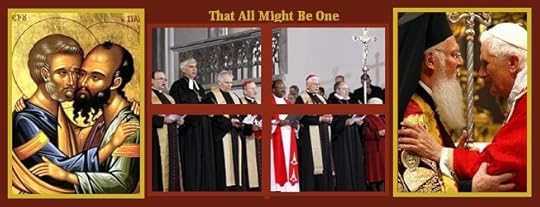Carl E. Olson's Blog, page 113
January 20, 2014
Where is Prayer for Christian Unity in Our Parishes?
Where is Prayer for Christian Unity in Our Parishes? | James Likoudis | HPR
Every post-conciliar Pope has emphasized, with Vatican II, that ecumenism is a necessary aspect of the Church’s mission, and one involving the effort of all the faithful, clergy, and laity alike.
It was once quite common for many Catholic parishes to celebrate the week of January 18-25 (from the Feast of St. Peter’s Chair at Rome to the Feast of the Conversion of St. Paul) for fervent prayers to God for the Unity of Christians separated from the visible Unity of the Catholic Church. There were also fervent prayers for lapsed Catholics and for the conversion of Jews to the Christian Faith. There is no question that, in the last four decades, post-conciliar, doctrinal, and liturgical disorders, together with the spread of religious indifferentism, have resulted in the weakening, or actual loss, of Catholic identity among many professed Catholics who no longer express concern or care for the salvation of others. The grave error that has spread is that it makes no difference whether a person is an actual member of the Catholic Church or not, as long as he is sincere in his particular belief.
All this has occurred despite the Second Vatican Council’s insistence that “Christ the Lord founded one Church and one Church only” and exhorting every Catholic to pray for an end to the historical divisions among Christians which “contradict the will of Christ, scandalizes the world, and damages that most holy cause, the preaching of the Gospel to every creature.” (Decree on Ecumenism §1). Catholics are reminded further that:
Our separated brethren, whether considered as individuals or communities, and Churches, are not blessed with that Unity which Jesus wished to bestow on all those who to whom he has given new birth into one body, and whom he has quickened to newness of life—that Unity which the Holy Scriptures and the ancient Tradition of the Church proclaim. For it is through Christ’s Catholic Church alone, which is the universal help towards salvation, that the fullness of the means of salvation can be obtained. It was to the apostolic college alone, of which Peter is the head, that we believe entrusted all the blessings of the New Covenant, in order to establish on earth the One Body of Christ into which all those should be fully incorporated who belong in any way to the People of God … To attain that fullness of Unity which Jesus Christ desires, the Sacred Council exhorts all the Catholic faithful to recognize the signs of the times and to take an active and intelligent part in the work of ecumenism (Ibid., §3 and 4).
From the days of Blessed Pope Pius IX in the 19th century, the Popes have attempted to reach out, with great charity, to those “other sheep” separated from the One Flock committed to Peter, Chief of the Apostles.
January 18, 2014
The Lamb of God and the Salvation of the World
A Scriptural Reflection on the Readings for Sunday, January 19, 2014 | Carl E. Olson
Readings:
• Is 49:3, 5-6
• Ps 40:2, 4, 7-8, 8-9, 10
• 1 Cor 1:1-3
• Jn 1:29-34
Taken as a whole, today’s readings can, I think, be summarized in a single sentence: The Son of God became a servant so that by becoming a sacrifice he would be the Savior of mankind.
Let’s take a closer look at each of these names and titles, beginning with the final statement from today’s Gospel, a declaration uttered by John the Baptist at the Jordan River: “Now I have seen and testified that he is the Son of God.” This testimony to the identity of Jesus is a key theme in the Gospel of John, as indicated in the Evangelist’s theological commentary following Jesus’ discourse to Nicodemus: “He who believes in him is not condemned; he who does not believe is condemned already, because he has not believed in the name of the only Son of God” (Jn 3:18).
And, at the close of his Gospel, the Apostle John explains that his testimony was written so “that you may believe that Jesus is the Christ, the Son of God, and that believing you may have life in his name” (Jn 20:31). We cannot begin to understand fully the servanthood and the sacrifice of Jesus without first recognizing that he is the Son of God.
The Old Testament contains a number of prophetic passages about a coming servant of the Lord who would establish God’s reign and being peace to Israel. Isaiah has several “servant songs”, the most famous being found in chapters 52 and 53 (and read during Holy Week). The servant song in chapter 49 closely aligns the servant with Israel, which highlights the fact that salvation, as Jesus told the Samaritan woman, is from the Jews (Jn 4:22).
But the servant emerges from Israel; he is a man with a singular identity and possessing unique qualities, through whom salvation will come not only to Israel but to all men: “I will make you a light to the nations, that my salvation may reach to the ends of the earth.” The season of Christmas, of course, focuses on the remarkable and radical fact that the Son became a servant, leaving the glory of heaven to dwell among men.
The eternal Word, in becoming man, willingly became a servant and embraced the work of sacrifice set before him. “From the beginning of his public life,” the Catechism states, “at his baptism, Jesus is the ‘Servant’, wholly consecrated to the redemptive work that he will accomplish by the ‘baptism’ of his Passion” (par 565). One can only imagine the shock caused by John the Baptist’s emphatic exclamation, “Behold, the Lamb of God, who takes away the sin of the world.”
Under the Law, there were several animals that were sacrificed at various times for the sins of the people; these included bulls, goats, pigeons, doves, and sheep (cf. Lev. 12:6). And among sheep there were three types: rams, ewes, and lambs. Why was Jesus identified as the “Lamb of God”? “It is the lamb,” answered Origen to this question, “that we find offered in the perpetual sacrifices [cf. Ex 29:38].” In addition, it points back to the blood of the unblemished Passover lambs that liberated the Hebrews from slavery in Egypt (Ex. 12).
The Cross is at the heart of the New Exodus, an act of humility, sacrifice, and love liberating man from the power of sin and death. Those who do not recognize Jesus as the Son of God look upon the Cross and see failure and shame. But those who know that Jesus is the Lamb of God see love and grace, what Joseph Cardinal Ratzinger describes as the moment “when God transforms this external violence against him into an act of self-donation to mankind.”
Those who see the Savior on the Cross and become united to him through baptism are, in the words of the Apostle Paul, those “who have been sanctified in Christ Jesus, called to be holy…” They are called, by grace, to be sons and daughters of God.
(This "Opening the Word" column originally appeared in the January 16, 2011 edition of Our Sunday Visitor newspaper.)
What’s Normal?

What’s Normal? | James Kalb | Catholic World Report
Why should we want to be ordered around by social engineers who don’t understand what they’re doing?
The great political, social, and moral issue of the present day is the authority of the natural and normal.
Accepting that authority means accepting a vernacular form of natural law, and thus a belief that the world has an innate way of functioning that is presumptively good. We can understand a great deal about that way of functioning, since otherwise reason would be of little use to us. Nonetheless, many of the details escape us, because the world is complicated and we didn’t create it. It has its own principles, and goes its own way.
For that reason, accepting nature means trusting the world more and ourselves less than is usual today. It means letting most things follow their own course, and dealing with what seems amiss with the aid of informal and inexact kinds of knowledge, like tradition and common sense, that fit situations that can’t be analyzed and resolved precisely.
The liberal technocratic view now dominant is very different. It wants to put individual man wholly in command, and tells us that the way the world is constituted has no authority. We should view everything around us, even our own bodies, as raw material for our purposes, and make things work the way we want them to work without worrying about what they’re for or what’s natural for them.
Another way to make the point is to say that each of us should define his own version of what’s natural. That is the source of the emerging view of transsexualism, which denies that the human body has a nature of its own, and tells us we are men or women only if we agree to be. The effect of such an outlook on public life can be seen in Planned Parenthood v. Casey, a 1992 Supreme Court case that traced the right to abortion to “the right to define one’s own concept of existence, of meaning, of the universe, and of the mystery of human life.” On such a view, the way the mother defines the world determines whether her baby is a baby. To say otherwise is to violate her liberty.
In support of such views, proponents say that “natural” has no intrinsic meaning, since all events are equally real, and there’s no point claiming some of them are more in accord with the way the world is constituted than others.
January 16, 2014
March On!

Madeline Bauer of St. Paul, Minn., stands in front of the U.S. Supreme Court building during the March for Life in Washington Jan. 25, 2013. (CNS photo/Lisa Johnston, St. Louis Review)
March On! | John Burger | CWR
Roe v. Wade anniversary draws pro-life activists to events in Washington, DC, San Francisco, and other cities.
Pro-life leaders find hope in the fact that 41 years after the Supreme Court was thought to have settled a controversy with Roe v. Wade, more and more Americans are unsettled about legalized abortion.
“We are waking up,” said Father Frank Pavone, national director of Priests for Life. “We are waking up to the extremism of our public policy on abortion…. We are waking up to the pain that abortion causes.”
The trial of Philadelphia abortionist Kermit Gosnell last spring, which exposed some gruesome practices that can go on in some abortion clinics, as well as a continuing focus on partial-birth abortion and the pain that babies can feel during an abortion have contributed to that awakening, pro-life activists said in recent interviews. Even the controversy over the HHS mandate of the Affordable Care Act has potential as a pro-life teaching tool.
“For two or three weeks we heard about all the atrocious things happening in [Gosnell’s] clinic,” said Jeanne Monahan, president of the March for Life Education and Defense Fund. “Americans were impacted by it. Similar to the partial-birth abortion debate in Congress, these kinds of things bring to light the reality of abortion and some of the people involved in doing abortion and some of the women who suffer at the hands of this industry.”
Father Pavone said that while the abortion industry is “trying to pass it off as a benefit,” abortion is “hurting the people it’s claiming to help.” Like a bad product, he said, it “needs to be recalled.”
“There is an awakening here—more and more people knowing others who have manifested that pain in their own lives, more and more people experiencing it themselves. So all of this for the movement overall is a step in the right direction as we wake up out of denial.”
Monahan will lead the March for Life and the rally preceding it in Washington, DC on Wednesday, January 22. Other speakers will include Dr. James C. Dobson of Focus on the Family.
Led this year by students from Benedictine University in Atchison, Kansas, the march will follow Constitution Avenue up to the United States Supreme Court building where, 41 years ago to the day, seven out of the nine justices struck down most state laws prohibiting abortion.
January 15, 2014
Canon Law Clash Alert!
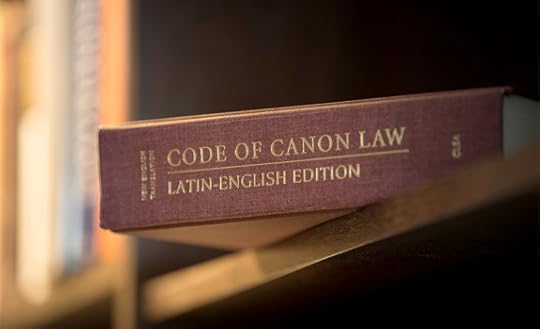
by Carl E. Olson | CWR blog
My headline could have also read: "Canon Law Class Alert!" We begin over at National "Catholic" Reporter, where Fr. Peter Daly begins with this bit of snarkiness:
The pope wants to know what we think.
That in and of itself qualifies as a minor miracle. In our top-down hierarchical church, the concept of the sensus fidelium has been pretty much a dead letter since the Second Vatican Council. Usually Rome talks and we listen. But now he wants to hear from us. Thank you.
It's hardly surprising to read this sort of thinly veiled sneering in the NCReporter. And to think that Michael Sean Winters, who does something or other for the same rag, recently chastised Fr. James Schall, SJ, for being "astonishingly condescending" because Fr. Schall, in a feature essay for this site, offered a mild—as well as cogent and learned—critique of some remarks made by Pope Francis about economics and politics. (By the way, I've read hundreds of Schall columns, many of which I've edited, and the man is never "condescending. I've read dozens of Winters' posts, and they are almost all condescending. Astonishing? No, not at all.)
But I digress. Fr. Daly continues:
Father Percy vs. Mister Francis: Apostasy and Liturgy in "Lord of the World"
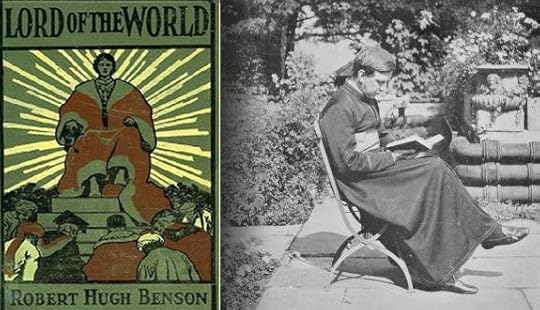
An early edition of Lord of the World and Fr. Robert Hugh Benson in 1913.
Father Percy vs. Mister Francis: Apostasy and Liturgy in Lord of the World | Dorothy Cummings McLean
Fr. Robert Hugh Benson's 1908 novel is remarkably prophetic, especially regarding apostasy
In a homily last November, Pope Francis referred to a novel by Fr. Robert Hugh Benson called Lord of the World. Fr. Benson was the son of an Archbishop of Canterbury. He made headlines when in 1902 he became a Catholic and again in 1904 when he was ordained a Catholic priest.
Father Benson, who died aged 43 in , spent his last decade preaching, counselling and, above all, writing sermons, apologetics, and novels. As a high profile Anglican who had become a Roman Catholic priest, he defended not only the Catholic faith but Catholic liturgical practises deplored by Protestant Britain. The challenges of a Catholic minority despised by the non-Catholic majority caught his imagination: both his apocalyptic Lord of the World (1908) and historical Come Rack! Come Rope! (1912) explore the choices of English Catholics suddenly enveloped by violent persecution.
The Holy Father’s attention was caught by the prophetic nature of Lord of the World, and indeed there are some startling parallels between the 21st century envisioned by Fr. Benson and our own. When the novel begins, the competing powers are the American Republic (which, manifesting its destiny, has swallowed the whole continent), a Europe Union, and an Eastern Empire dominated by China/Japan and Islam. Monarchy has been abolished in Europe; both America and England are socialist republics. The religion of the ruling classes, and indeed of the majority of the people in the West, is atheist humanism. And as there exist bombs that can wipe out entire cities, the West fears very much a war with the East. Oh, and a junior senator rising suddenly to prominence in America may well be the Anti-Christ. I kid you not.
Benson is at his most generous when he describes the atheist humanism of his European dystopia.
January 14, 2014
Fostering a Culture of Vocation and Evangelization in Vancouver, BC
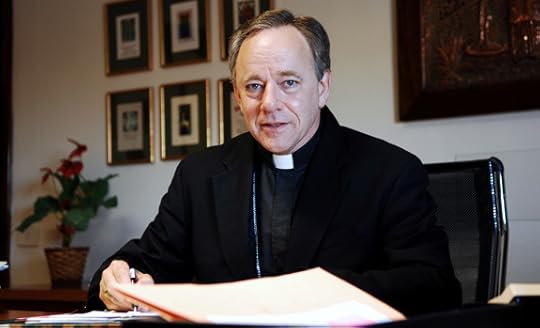
Archbishop J. Michael Miller, pictured in June 2007.
(CNS photo/Giancarlo Giuliani, Catholic Press Photo)
Fostering a Culture of Vocation and Evangelization in Vancouver, BC | Jim Graves | Catholic World Report
An interview with Archbishop J. Michael Miller of Vancouver, British Columbia, who has just celebrated the 10th anniversary of his episcopal ordination.
Archbishop J. Michael Miller of Vancouver, British Columbia, Canada celebrated the 10th anniversary of his episcopal ordination on Sunday, January 12.
Archbishop Miller, 67, was born in Ottawa. He joined the Basilian Fathers, who once had a significant presence in Canada and the United States, and was ordained a priest by Pope Paul VI in 1975. He went on to work in academia and in the Vatican. In 2003 Pope John Paul II appointed Miller to the episcopacy and named him secretary of the Vatican’s Congregation for Catholic Education and vice president of the Pontifical Work of Priestly Vocations. In 2009, Miller became archbishop of Vancouver. The region is home to about five million Canadians, of which 460,000 are Catholic.
Archbishop Miller is fluent in four languages, has received six honorary doctorates, and is a specialist on the papacy and modern papal teaching. He is author of seven books, including one on the development of the papacy and Catholic education. He is a naturalized American citizen.
Archbishop Miller recently spoke with CWR.
CWR: Tell us about your upbringing and how you decided to become a priest.
Archbishop J. Michael Miller: I was born in Ottawa. My father was Catholic and my mother was not, so I was the child of a mixed marriage. I attended Catholic schools when I was growing up, including a high school run by the Basilian Fathers.
The Basilan Fathers are teachers. I wanted to teach, so I thought it would be a good fit and a good way to serve the Lord. I know a lot of guys today have dramatic stories about how they decided to enter the seminary; [laughing] I guess we were less romantic in those days. It was the early 1960s, and it was commonplace. Lots of guys entered the seminary. I was one of them.
The Basilian Fathers had a lot of vocations in those days, and had schools in many cities.
CWR: How has the Church in Canada changed since you first entered the novitiate?
January 13, 2014
The Russian Orthodox Church and the Papacy
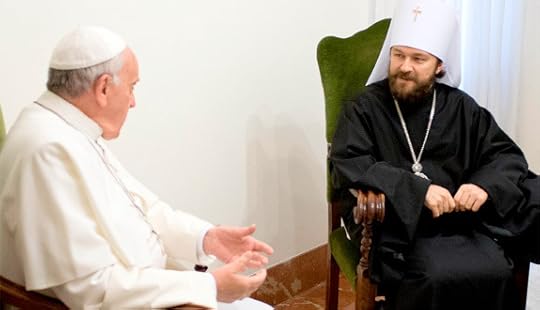
Pope Francis meets with Metropolitan Hilarion of Volokolamsk, head of ecumenical relations for the Russian Orthodox Church, during a private meeting at the Vatican Nov. 12. (CNS photo/L'Osservatore Romano vi a Reuters)
The Russian Orthodox Church and the Papacy | Dr. Adam A. J. DeVille | CWR
The recent statement by the Moscow Patriarchate “on the problem of primacy” is born of desperate, and desperately sad, insecurity
Nearly three years ago now, I published a book on Orthodoxy and papal primacy and, at risk of being immodest, have since felt more and more that I had said everything that needed to be said on the topic. But the whole question, which has been at the top of the international Orthodox-Catholic dialogue for two decades now, recently roared back with a statement issued the day after Christmas by the Russian Orthodox Church, titled, “Position of the Moscow Patriarchate on the problem of primacy in the Universal Church”. The statement of the Russian Church, which is technically the largest Orthodox Church in the world (if one counts sheer numbers of people claiming to be Orthodox rather than, say, levels of sacramental practice or church attendance), may be read here, but I would also want to direct your attention to responses from individual Orthodox theologians, including my friend the Russian Orthodox historian Antoine Arjakovsky here and a semi-official Greek response here, both of which are extremely valuable and far more soundly argued than the Russian statement.
I glanced at the Russian statement in the lazy days of the Christmas break, and seeing little that is new or interesting, asked myself: Have I not said everything that needs to be said in my Orthodoxy and the Roman Papacy: Ut Unum Sint and the Prospects of East-West Unity? But in re-reading the statement a few days ago, I found that perhaps there are a few things to comment on. The Russian statement purports to offer an alternative Orthodox response to the 2007 Ravenna document (about which I have published elsewhere) of the official international Orthodox-Catholic dialogue, a meeting from which the Russians absented themselves for reasons I have always found less than convincing.
And that is also my response to this new statement of theirs: it is less than convincing.
Let us pick up at paragraph 3 and its opening claim: "On the level of the Universal Church as a community of autocephalous Local Churches united in one family by a common confession of faith and living in sacramental communion with one another, primacy is determined in conformity with the tradition of sacred diptychs and represents primacy in honour" (emphasis in the original).
The statement, not surprisingly, never defines this "primacy in honour," though it uses the phrase several subsequent times.
Cardinal Nguyen Van Thuan: An Icon of the Vietnamese Church
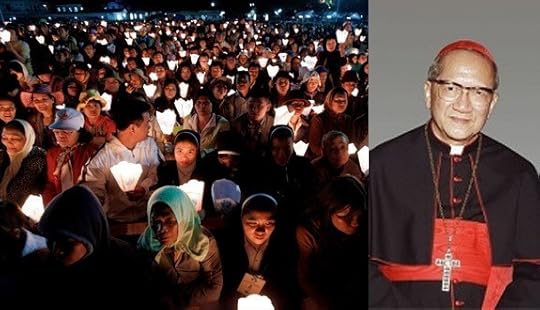
(Left) People hold candles while attending a Mass as part of the holy year celebrations outside La Vang Basilica in Vietnam's central Quang Tri province Jan. 5, 2011. (CNS photo/Kham, Reuters) (Right) Cardinal Francis Xavier Nguyen Van Thuan
Cardinal Nguyen Van Thuan: An Icon of the Vietnamese Church | Sr. Maria Thuan Nguyen | CWR
Representing the resilience and fidelity of Vietnamese Catholics, Cardinal Thuan’s life reminds Christians everywhere to proclaim the Gospel in all circumstances.
On July 5, 2013, jubilant Vietnamese Catholics celebrated the closing of the diocesan phase of Cardinal Francis Xavier Nguyen Van Thuan’s beatification process. Although he is not yet canonized, the Vietnamese faithful already consider him a saint and view him as an icon of the Vietnamese Church. As a second-generation Vietnamese American Catholic, I did not realize the beauty of my heritage until I became acquainted with Cardinal Thuan while I was a postulant in my religious community. Cardinal Thuan, being a man of faith, hope, and charity, epitomizes the virtues of past and present Vietnamese Catholics and is a model for Christians around the world.
Cardinal Nguyen Van Thuan was born on April 17, 1928, and from a young age, his character was shaped by the ideals of his heritage. He knew that he was called to communicate the best of Vietnamese culture. In 1941, he joined the Catholic seminary and was ordained a priest in 1953. Shortly after he was made coadjutor archbishop of Saigon in 1975, he was arrested and imprisoned by the Communists because of his Catholic faith. After 13 years of imprisonment, nine of which were spent in solitary confinement, then-Archbishop Thuan was released on the Feast of the Presentation of Our Lady. While in prison, he manifested the virtues cherished by Vietnamese Catholics. These virtues, however, do not only resonate in his life but also resound in the past and present Vietnamese faithful.
One of the prized virtues of the Vietnamese martyrs is fidelity to Christ, even in the midst of profound hardship. Because rulers feared that Christianity would threaten the established order, Vietnamese kings and emperors persecuted Catholics intermittently from 1644 to 1888. Two hundred and forty-four years of interspersed persecutions bore fruit in the martyrdom of 150,000 (see Miracle of Hope by Andre Van Chau Nguyen, 10). When the Communist government began harassing Catholics less than 100 years later, Catholics continued to witness to Christ crucified. Vietnamese Catholics were not only steadfast but often innovative and proactive in their faith.
In his book All Honor to You: The Journey of Faith Toward Life and Love, Father Peter Quang recounts his own heroic story, telling how he escaped from Vietnam on a boat in hopes of studying for the priesthood.
January 11, 2014
Was it fitting and necessary for Jesus to be baptized?
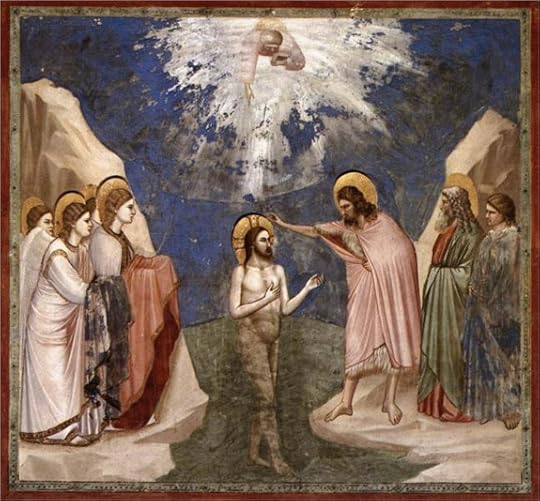
"The Baptism of Christ" by Giotto (c. 1305)
A Scriptural Reflection on the Readings for Sunday, January 12, 2014 | Feast of the Baptism of the Lord
Readings:
• is 42:1-4, 6-7
• Ps 29:1-2, 3-4, 3, 9-10
• Acts 10:34-38
• Mt 3:13-17
Was it fitting and necessary for Jesus to be baptized? It is an important question the answer says much about the person and mission of Jesus. It has, therefore, been taken up by theologians and Doctors of the Church over the centuries.
St. Thomas Aquinas, in the Summa Theologica (see ST 3, 39, 1-8), listed a number of objections, including, “It would seem that it was not fitting for Christ to be baptized. For to be baptized is to be washed. But it was not fitting for Christ to be washed, since there was no uncleanness in Him. Therefore it seems unfitting for Christ to be baptized.” His answer draws upon both Scripture and the Church Fathers: “I answer that, It was fitting for Christ to be baptized. First, because, as Ambrose says on Luke 3:21: ‘Our Lord was baptized because He wished, not to be cleansed, but to cleanse the waters, that, being purified by the flesh of Christ that knew no sin, they might have the virtue of baptism’.”
He also quoted St. Gregory Nazianzen, who had written, “Christ was baptized that He might plunge the old Adam entirely in the water.” He further noted that Jesus, in being baptized, was setting an example for everyone who would follow him and take up the cross of discipleship. After all, if the sinless Son of God would willingly enter the waters of baptism, how much more urgent is it that we sinners are washed in the waters of regeneration?
There are other reasons given, including one implicit in the sermon of St. Peter to the first Gentile convert, Cornelius, heard in today’s reading from the Acts of the Apostles: “You know the word that [God] sent to the Israelites as he proclaimed peace through Jesus Christ, who is Lord of all, what has happened all over Judea, beginning in Galilee after the baptism that John preached, how God anointed Jesus of Nazareth with the Holy Spirit and power.”
Here the emphasis is on the anointing; the Greek word is echrisen (ἔχρισεν) and the root word is chrió, from which comes the word “Christ”. And the title “Christ” is itself the Greek translation of the Hebrew word, “Messiah”, which means “anointed”. The Catechism explains that this is “the name proper to Jesus only because he accomplished perfectly the divine mission that ‘Christ’ signifies. In effect, in Israel those consecrated to God for a mission that he gave were anointed in his name. This was the case for kings, for priests and, in rare instances, for prophets. This had to be the case all the more so for the Messiah whom God would send to inaugurate his kingdom definitively” (par. 436). Jesus was anointed by the Holy Spirit and presented as uniquely fulfilling the threefold office of prophet, priest, and king.
The term “Messiah” occurs some five hundred thirty times in the Old Testament, and the importance of the title would be difficult to overstate. For example, Psalm 45, one of the messianic psalms, states this of the anticipated Messiah: “Your throne, O god, stands forever; your royal scepter is a scepter for justice. You love justice and hate wrongdoing; therefore God, your God, has anointed you with the oil of gladness above your fellow kings” (Ps 45:7-8). Jesus, however, was not anointed as Messiah by oil; instead, the Spirit of God descended “like a dove” and the Father spoke his words of blessing, “This is my beloved Son, with whom I am well pleased.”
Thus, wrote St. Irenaeus, the one “who anointed is the Father, the one who was anointed is the Son, and he was anointed with the Spirit who is the anointing” (see CCC, 438). He further noted that this same anointing of the Holy Spirit is given to all those baptized into Jesus the Christ. Entering the waters prepared by Christ, the baptized emerge cleansed by the Holy Spirit, filled with divine life, made children of the Father.
(This "Opening the Word" column originally appeared in the January 9, 2011, issue of Our Sunday Visitor newspaper.)
Carl E. Olson's Blog
- Carl E. Olson's profile
- 20 followers


